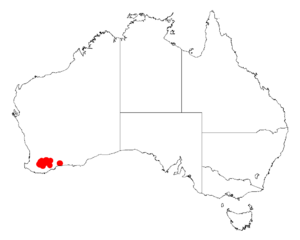Acacia grisea facts for kids
Quick facts for kids Acacia grisea |
|
|---|---|
| Scientific classification | |
| Genus: |
Acacia
|
| Species: |
grisea
|
 |
|
| Occurrence data from AVH | |
Acacia grisea is a type of small shrub, also known as a wattle, that belongs to the Acacia family. It grows only in a specific part of southwestern Australia, meaning it's endemic there.
Contents
What is Acacia grisea?
This plant is a small shrub that usually grows between 0.1 and 0.6 meters (about 4 inches to 2 feet) tall. Its small branches are covered in tiny hairs.
Leaves and Flowers
The leaves of Acacia grisea are quite special. They have two main parts called pinnae. The pinnae closer to the stem are shorter, about 2 to 4 millimeters long. The pinnae further away are longer, about 5 to 10 millimeters long.
Each of these pinnae has even smaller leaf parts called pinnules. The closer pinnae have 2 to 3 pairs of pinnules. The longer pinnae have 4 to 7 pairs of pinnules. These pinnules are slightly thick, hairy, and have a grey-green color. They are shaped like small rectangles, about 2 to 4 millimeters long and 1 to 2 millimeters wide.
Acacia grisea blooms with bright yellow flowers from June to August. The flowers grow in round, ball-shaped clusters. Each cluster has between 16 and 26 golden-colored flowers. These flower clusters grow by themselves where the leaves meet the stem.
Seed Pods
After the flowers, the plant forms hairy seed pods. These pods are about 2 to 4 centimeters (about 1 to 1.5 inches) long. Inside the pods, you'll find oblong or oval-shaped seeds, each about 3 millimeters long.
How is it Related to Other Plants?
Acacia grisea is closely related to another wattle called Acacia browniana. Acacia browniana is found closer to the coast in Australia. Being "closely related" means they share a common ancestor and have many similar features.
Where Does it Grow?
This wattle is native to the Wheatbelt and Great Southern areas of Western Australia. It likes to grow on slopes and flat plains. You'll often find it in gravelly, loamy soils that are rich in iron, known as lateritic soils.
The plant's natural home stretches from the town of Kukerin in the north. It goes down to Kojonup in the southwest and Broomehill in the southeast.
Images for kids


